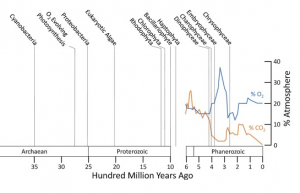DOI: 10.1016/j.plantsci.2017.12.002
The many types of carbonic anhydrases in photosynthetic organisms
Abstract
 Carbonic anhydrases (CAs) are enzymes that catalyze the interconversion of CO2 and HCO3−. In nature, there are multiple families of CA, designated with the Greek letters α through θ. CAs are ubiquitous in plants, algae and photosynthetic bacteria, often playing essential roles in the CO2 concentrating mechanisms (CCMs) which enhance the delivery of CO2 to Rubisco. As algal CCMs become better characterized, it is clear that different types of CAs are playing the same role in different algae. For example, an α-CA catalyzes the conversion of accumulated HCO3− to CO2 in the green alga Chlamydomonas reinhardtii, while a θ-CA performs the same function in the diatom Phaeodactylum tricornutum. In this review we argue that, in addition to its role of delivering CO2 for photosynthesis, other metabolic roles of CA have likely changed as the Earth’s atmospheric CO2 level decreased. Since the algal and plant lineages diverged well before the decrease in atmospheric CO2, it is likely that plant, algae and photosynthetic bacteria all adapted independently to the drop in atmospheric CO2. In light of this, we will discuss how the roles of CAs may have changed over time, focusing on the role of CA in pH regulation, how CAs affect CO2 supply for photosynthesis and how CAs may help in the delivery of HCO3− for other metabolic reactions.
Carbonic anhydrases (CAs) are enzymes that catalyze the interconversion of CO2 and HCO3−. In nature, there are multiple families of CA, designated with the Greek letters α through θ. CAs are ubiquitous in plants, algae and photosynthetic bacteria, often playing essential roles in the CO2 concentrating mechanisms (CCMs) which enhance the delivery of CO2 to Rubisco. As algal CCMs become better characterized, it is clear that different types of CAs are playing the same role in different algae. For example, an α-CA catalyzes the conversion of accumulated HCO3− to CO2 in the green alga Chlamydomonas reinhardtii, while a θ-CA performs the same function in the diatom Phaeodactylum tricornutum. In this review we argue that, in addition to its role of delivering CO2 for photosynthesis, other metabolic roles of CA have likely changed as the Earth’s atmospheric CO2 level decreased. Since the algal and plant lineages diverged well before the decrease in atmospheric CO2, it is likely that plant, algae and photosynthetic bacteria all adapted independently to the drop in atmospheric CO2. In light of this, we will discuss how the roles of CAs may have changed over time, focusing on the role of CA in pH regulation, how CAs affect CO2 supply for photosynthesis and how CAs may help in the delivery of HCO3− for other metabolic reactions.
